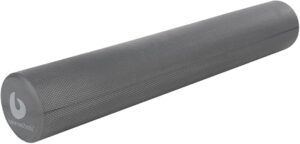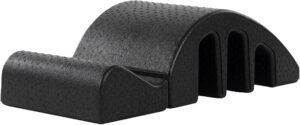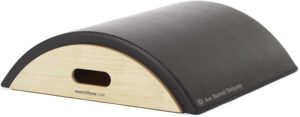In-studio Pilates workouts often rely on specialized equipment like barrels to deepen the practice and target specific muscle groups. However, not everyone has access to a full set of Pilates apparatus at home. The good news is that a foam roller can be a versatile and effective substitute for small barrels, allowing you to enhance your home Pilates workout without the need for expensive or bulky equipment.
In this post, We’ll explore how to use a foam roller in place of a small Pilates barrel and how to incorporate it into classical mat exercises to maximize your workout. And if you’re looking for guidance to get started, private virtual lessons through our studio are available to help you master these techniques from the comfort of your home.
The Benefits of Using a Foam Roller
A foam roller offers several benefits that make it an excellent hack for a small Pilates barrel:
- Accessibility: Foam rollers are affordable, portable, and easy to store, making them accessible for home workouts.
- Versatility: Foam rollers can be used in various ways to mimic the curvature and support of Pilates barrels.
- Muscle Activation: Using a foam roller can increase muscle activation, challenge your balance, and provide a deeper stretch.
Classical Pilates Exercises Adapted with a Foam Roller
Let’s dive into some classical Pilates mat exercises and how they can be adapted with a foam roller to mimic the effects of working on a barrel.
Roll-Up
- Traditional Barrel: The barrel is used to support the upper spine, allowing for a more gradual and controlled roll-up.
- On the Foam Roller: Place the foam roller lengthwise along your spine, from your tailbone to your head. Begin with your arms extended overhead, and as you exhale, engage your core and slowly roll up, reaching towards your toes. The foam roller will challenge your stability, making your core work harder to control the movement.
Spine Stretch Forward
- Traditional Barrel: The barrel provides support for the hips and helps to deepen the stretch.
- On the Foam Roller: Sit with your legs extended and place the foam roller under your knees. As you exhale, hinge forward from your hips, reaching your hands towards your feet. The foam roller elevates your legs slightly, allowing for a deeper stretch in your hamstrings and lower back.
Short Box Series (Side-to-Side)
- Traditional Barrel: The barrel offers a curved surface for side bends, supporting the spine and deepening the stretch.
- On the Foam Roller: Sit on the roller, ensuring it’s positioned under your sit bones, and place your feet flat on the floor. Extend your arms out to the sides and, as you inhale, reach one arm overhead while bending to the opposite side. The foam roller will challenge your balance, requiring greater core engagement to maintain stability.
Shoulder Bridge
- Traditional Barrel: The barrel supports the back and encourages a more lifted and open chest position.
- On the Foam Roller: Lie on your back with your feet flat on the roller. As you exhale, engage your glutes and hamstrings to lift your hips into a bridge position. The instability of the roller under your feet will intensify the exercise, targeting your core and lower body muscles.
Swan Dive
- Traditional Barrel: The barrel provides support for the spine when you are prone and allows for a more controlled back extension.
- On the Foam Roller: Place the foam roller under your pelvis, with your legs extended behind you. As you inhale, lift your chest and legs off the mat, engaging your back extensors. The foam roller will support your pelvis, enabling a smoother and more controlled extension. It can also be placed at the wrists for a gentler variation.
Tips for Using the Foam Roller Safely
- Start Slow: If you’re new to using a foam roller, start with basic exercises to get comfortable with the instability it introduces.
- Focus on Alignment: Keep your body aligned throughout each exercise, especially when balancing on the roller.
- Engage Your Core: The foam roller will challenge your stability, so engage your core muscles to maintain control and prevent injury.
- Modify as Needed: If an exercise feels too challenging, reduce the range of motion or try the exercise without the foam roller until you build strength and stability.
Get Started with Private Virtual Lessons
If you’re looking for personalized guidance on how to use a foam roller as a substitute at home for the small Pilates barrel, consider signing up for private virtual lessons through our studio. Our experienced instructors can help you master these techniques, tailor exercises to your fitness level, and provide real-time feedback—all from the comfort of your own home. Whether you’re a seasoned Pilates practitioner or new to the method, our virtual lessons can support your journey.
Conclusion
Using a foam roller as a substitute for a small Pilates barrel in your home workout is an excellent way to enhance your practice, deepen your stretches, and challenge your core stability. By incorporating the roller into classical Pilates mat and barrel exercises, you can mimic the benefits of working on a barrel while enjoying the convenience of home-based workouts. With the option of virtual lessons, you can receive expert guidance to ensure you’re getting the most out of your practice.
Don’t have a roller at home? Here is our pick! It’s the one we have in the studio.
Want to get a small barrel for home use? Here are our 2 picks.
Tags: #PilatesAtHome #HomeWorkout #PilatesLovers #FoamRoller #ClassicalPilates #CoreStrength #NoEquipmentNeeded #AffordableFitness #PilatesBarrelSubstitute




